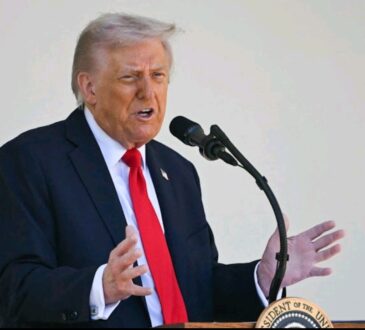North Korea threatens ‘nuclear war’ in space after slamming Trump’s $175,000,000,000 ‘golden dome’

President Donald Trump’s recent unveiling of the Golden Dome missile defense initiative has sparked a wave of international condemnation and renewed fears of a militarized space arms race. Announced from the Oval Office on May 20, the \$175 billion proposal aims to create an advanced, space-based missile interception system capable of neutralizing threats at every stage of a missile’s trajectory—even if launched from space.
The initiative is designed to respond to growing concerns about the capabilities of countries like China and Russia, which have reportedly deployed offensive technologies capable of targeting critical U.S. satellite infrastructure.
The Golden Dome is envisioned as a multi-layered defense system that can detect, track, and intercept missiles before launch, during boost, in mid-course, and during their final descent. It marks a dramatic escalation in the U.S.’s approach to national security and reflects the Pentagon’s warnings that space is becoming a domain of warfare.
The system’s initial implementation is expected to cost \$25 billion, with the total projected cost reaching \$175 billion. However, independent analysts, including the Congressional Budget Office, have estimated the space-based component of the system alone could balloon to over \$500 billion across the next two decades.
General Chance Saltzman, the head of the U.S. Space Force, has described the Golden Dome as an entirely new class of defense capabilities, one that introduces missions and responsibilities never before undertaken by military space operations.
The conceptual plan includes deploying hundreds of satellites equipped with advanced sensors and interceptors, some potentially armed with missiles or lasers, to form a global shield in orbit.
The Pentagon has reportedly held meetings with private companies to develop this capability, including SpaceX, Palantir, and Anduril, with Elon Musk’s firm emerging as a frontrunner due to its track record in space launches and satellite technology.
However, the announcement has triggered a sharp rebuke from North Korea. The regime issued a fiery statement through its state-run Korean Central News Agency, declaring the U.S. plan to be a dangerous provocation that could transform outer space into a battleground for nuclear war.
The North Korean foreign ministry accused the U.S. of destabilizing global security and violating the principles of peaceful space exploration by aggressively pursuing the militarization of space under the guise of national defense. According to Pyongyang, the Golden Dome is the primary catalyst behind what it sees as an accelerating global arms race in both nuclear and space-based weaponry.
North Korea’s warning is not isolated. China also responded swiftly to the U.S. announcement. In a statement by Foreign Ministry spokesperson Mao Ning, China expressed deep concern and criticized the U.S. for seeking absolute security for itself at the expense of global strategic balance.
Beijing warned that the introduction of such a defense system could undermine decades of arms control agreements and cooperation in space, potentially forcing other nations to develop their own countermeasures. The Chinese government urged the U.S. to abandon its unilateral military ambitions in outer space, warning that continued pursuit of such initiatives would provoke instability and distrust among the world’s nuclear powers.
While the Trump administration insists that the Golden Dome is essential for preserving U.S. national security in the face of evolving threats, critics argue that the program could be counterproductive.
By pushing the boundaries of space militarization, the U.S. risks provoking adversaries into developing and deploying their own space-based weapons, leading to a new era of Cold War-style deterrence—but in orbit rather than on Earth. Defense analysts have also pointed out that despite the bold vision, the project currently lacks congressional funding and remains in a conceptual stage, with many technical, legal, and diplomatic hurdles still to be addressed.
Despite these obstacles, President Trump has stated that he wants the Golden Dome to be fully operational before the end of his term in 2029. As the political battle over funding and feasibility unfolds in Washington, the international response suggests that the program could become a defining issue not only for U.S.
defense policy but also for the global debate over the future of space governance and arms control. With nuclear-armed nations on edge and space already crowded with strategic assets, the emergence of a space-based missile defense shield may ultimately force a reckoning over how humanity will manage its activities—and its conflicts—beyond Earth’s atmosphere.




